|
Return to Spanish Civil War | Go
straight to Questions | Topic Plan
Sections: 1 | 2 | 3 | 4
Sources ( Click here for print friendly sources and questions)
Click here for print friendly sources and questions)
Here is a collection of sources dealing with the involvement of Welsh miners in the Spanish Civil War. Some of these are written sources (e.g. letters and newspaper articles), some are visual sources (e.g. photographs) and some are audio sources (tape recordings).
The written and visual sources appear as ‘thumbnails’, which can be enlarged by positioning the cursor on the image and clicking once. Why not enlarge and read some of the sources before answering the questions?
Alongside the thumbnails and audio clips are a series of questions. These are designed to help you to interpret the sources and use them as evidence for your statements about the role of Welsh miners in the Spanish Civil War.
Whereas some general questions can be applied to any source (How /why was it produced? What does it tell us about…..? How valuable/useful is it?), different kinds of
working questions tend to be associated with particular types of source.
Written sources:
Who was the author?
When was it written?
Under what circumstances/in what context was it written?
How did it come to light?
What was the intended audience?
How might this have affected the content/tone of the source?
What was the author’s likely perspective or point of view?
What is the author’s level of knowledge? What does he know/not know?
Is the author likely to have been ‘positioned’ in some way (unintended bias)?
Might the author have some reason for lying or distorting the truth (intended bias)?
Photographic sources (in addition to some of the above):
What does the photograph show?
What can we tell from the photograph about the period or events described?
What does the photograph not show – how is it limited?
How plausible/typical is the image – does it seem to have been ‘posed’ in some way?
What methods, if any, has the photographer used to create mood or feeling in the image?
Audio sources (taped reminiscences):
What is the speaker able to remember? Does it amount to a coherent account?
What has the speaker chosen to remember?
Are details of individual recounts backed up by other kinds of evidence?
How can we explain omissions in individual recounts?
What characteristics of the speaker are revealed by what he/she says?
Questions
SECTION 1 - REASONS FOR VOLUNTEERING:
Source 1: 

Memories of Edwin Greening of Aberdare – member of the British battalion of the International Brigade, 1937-9.
Source 2: 

Memories of James Brewer of Rhymney, Monmouthshire – member of the British Battalion of the International Brigade 1937-9.
Source 3: 

Memories of Michael O’Donoghue of Merthyr Tydfil – member of the British Battalion of the International Brigade 1937-9.
Source 4: [first two columns only]:
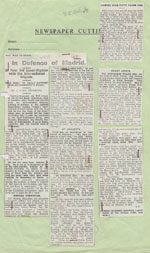
Date: 25 Apr 1937
Newspaper cutting relating to Will Lloyd of Aberaman, a
volunteer in the International Brigade on the Madrid Front (photocopy)
SECTION 1 – TASKS AND QUESTIONS:
-
First, click on Foreign Intervention and read this.
-
Next, listen to Sources 1-3 and study the newspaper article,
Source 4
-
Now, use Grid A (Copy shown below) to list the reasons given
in Sources 1-4 for volunteering to go to Spain.
Grid A:
| Source |
Volunteer(s) |
Reasons for volunteering to fight in Spain |
| 1 |
Edwin Greening |
|
| 2 |
James Brewer |
|
| 3 |
Michael O’Donoghue |
|
| 4 |
Will Lloyd / Bob Condon |
|
Now use this information to answer Question 1:
1(a) What reasons do the men (including ‘Our Own Reporter’ in Source 4) give for going to Spain?
1(b) Were all the reasons the same? If not, how would you account for this?
1(c) What political party do you think the Aberdare Leader supports?
1(d) These men were not usually well educated, so how would they have developed their knowledge of international politics?
SECTION 2- THE JOURNEY TO SPAIN:
(Sections: 1 | 2 | 3 | 4)
Source 5: 

Edwin Greening describes how he volunteered for Spain “through the Party”.
Source 6:

Edwin Greening describes recruitment procedures and the journey to Spain.
Source 7:

James Brewer describes his journey to Spain.
Source 8: 

Michael O’Donoghue describes his journey to Spain.
Source 9: [first two columns only]:

Date: 25 Apr 1937
Newspaper cutting relating to Will Lloyd of Aberaman, a
volunteer in the International Brigade on the Madrid Front (photocopy)
SECTION 2 – TASKS AND QUESTIONS:
-
First, look at Map 1: The Journey to Spain that appears at the beginning of the unit.
-
Next, look at “Foreign Intervention” and
quickly read what it says, and come back to these questions.
-
Now, with the map on screen, listen to each of the tape
extracts and summarise details using Grid B (copy below)..
Grid B:
| On Screen |
|
| Source |
Details of journey/arrival/training |
| 5 |
|
| 6 |
|
| 7 |
|
| 8 |
|
|
9 |
|
Question 2:
- Look back at Source 4. What evidence does the source contain that the journey to Spain had to be kept secret?
- How is this evidence supported by Sources 5-8?
- Why would these men have had to travel in secret?
- What similarities can be found in the travel experiences of Edwin Greening and James Brewer
(Sources 6 and 7)?
- Michael O’Donoghue (Source 8) is more secretive than the other two speakers. Does this make his ‘story’ more or less useful as evidence about the journey to
Spain?
- Look at Source 9 – what kinds of things were on the volunteers’ minds when writing home for the first time?
- Imagine you are a volunteer from South Wales. You have just arrived at the headquarters of the International Brigades in Albacete. Compose a letter to a relative back home describing your journey and first impressions of
Spain
| This is really a test of how well you have understood the evidence presented in Sources 5-9 and of how well you can
use details from the evidence to produce a well-structured account. You
will find Grid C (copy below) useful as a means of collecting details and organising your story:
|
| On Screen |
| Background – In work or unemployed? Political views? – reasons for volunteering? |
| Recruitment in Cardiff – Need for secrecy |
| Meeting with other volunteers in London |
| Paris and the journey through France |
| Arrival at Figueres, near Barcelona– initial training |
| Conditions in Albacete. – first thoughts about being a member of the International Brigade. |
SECTION 3- FIGHTING IN THE WAR:
(Sections: 1 | 2 | 3 | 4)
Source 10
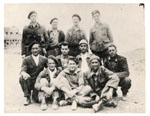
Welshmen in the International Brigades.
Back row, left to right: Alwyn Skinner of Neath (killed in Spain), Fred Morris, Maerdy, Ben Davies, Newport and C.E.Palmer of Llandudno.
Middle Row: Archie Cook, Ystrad Rhondda, Hector Manning, Dinas, Harry Dobson, Blaenclydach (killed in Spain), Arthur Williams, Penrhiwfer).
Front Row, Jack Roberts,Abertridwr, Ted Edwards, Machynlleth, Morris Davies, Treharris.
Source 11
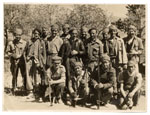
British platoon before the Ebro Offensive. Tom Glyn Evans of Kenfig Hill is standing centre, with beret and Morris Davies of Treharris is kneeling far right.
Source 12

British Battalion volunteers before the Ebro Offensive, Summer 1938. Brazell Thomas, Llanelli, is third from the left, front row.
Source 13
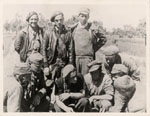
British Battalion officers before before the Ebro Offensive, Summer 1938. Standing, left to right, Fred Morris, Maerdy, Tom Glyn Evans, Kenfig Hill, Morris Davies, Treharris. Front centre with watch, Sam Wild, Battalion commander.
Source 14
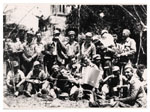
British Battalion volunteers at the front, including Jack Murray of Maesteg, standing third from the left.
Source 15 [SWCC DOC 206/04]:
Letter from Bob Condon of Aberaman to the ‘Aberdare Leader’ (April 1937) – “Bullets Singing Death”
Source 16 [SWCC DOC 206/06]:
Article from ‘Aberdare Leader’ (May 1937). Will Lloyd describes how British bravery in defence of the Valencia Road prevented the Fascists from taking Madrid.
Source 17: 

Edwin Greening describes his first experiences under fire.
Source 18: 
 Edwin Greening describes details of the action around Gandesa.
Edwin Greening describes details of the action around Gandesa.
Source 19:   Michael O’Donoghue describes fighting at Jamara and Brunete, including the deaths in action of Alwyn Harris of Llanelli and Ramon Rodriguez of Dowlais.
Source 20: 

James Brewer describes action on the Ebro, including comments on the effectiveness of ‘political commissars’.
Sources 21-23 [See below]:
Selection of Republican war posters produced during the Spanish Civil War.
SECTION 3- TASKS AND QUESTIONS:
Question 3:
- Study the photographs (Sources 10-14). What do they suggest about (i) the
mood, (ii) the equipment of the British Battalion?
- How useful are these images likely to be as evidence about soldiers’ experiences in the Spanish Civil War?
- What does Source 15 reveal about (i) the kind of people that joined the International Brigades, (ii) the attitudes of the Spanish people towards the International Brigades?
- How can you tell that The Aberdare Leader (Sources 15 and 16) was on the side of the Republicans?
- What overall impression is given in The Aberdare Leader about the attitudes of volunteers towards fighting in the Spanish Civil War?
- Given that Will Lloyd was back in South Wales to raise support for the Republican war effort when Source 16 was written, how reliable do you consider the source to be?
- Use Grid D (copy below) to make brief notes from the tapes (Sources 17-20) under the following headings:
| Aspect of fighting |
Source(s) |
Evidence |
| Basic training |
|
|
| Supplies & equipment |
|
|
| Details of fighting |
|
|
| Attitudes to the war |
|
|
- How far are attitudes to the war shown in the tapes (i) similar to, (ii) different from those suggested by The Aberdare Leader (Sources 15-16) and by the war posters (Sources
21-23)? Use Grid E (copy below) complete your
answer:
| Source type |
Attitudes to the war |
| Personal recollections |
|
| Aberdare Leader |
|
| War posters |
|
- This section contains several different kinds of historical sources. Using
Grid F (copy below), discuss the strengths and limitations of each as historical evidence about fighting in the Spanish Civil War.
| Type of source |
Content |
Strength(s) |
Limitation(s) |
| Photographs |
|
|
|
| Newspaper articles |
|
|
|
| Personal recollections |
|
|
|
| Posters |
|
|
|
| Source 21 |
 |
| |
|
| Source 22 |

|
| |
|
| Source 23 |

|
SECTION 4 – SUMMARY: WHAT KIND OF EXPERIENCE WAS IT?
(Sections: 1 | 2 | 3 | 4)
Look at the following comments by the famous writer, George Orwell. Orwell served in various Republican militias in and around Barcelona. He was not a member of the International Brigades and had made his own way to Spain rather than being recruited by the Communist Party as in the case of most of the Welsh volunteers.
The war… has left me with memories that are mostly evil, and yet I do not wish that I had missed it… Curiously enough the whole experience has left me with not less but more belief in the decency of human beings.
George Orwell, Homage to Catalonia (1938).
SECTION 4 - TASKS AND QUESTIONS:
Question 4:
- Using any of the sources provided, discuss whether or not the Welsh miners who went to Spain might have agreed with Orwell’s comments.
The following writing frame may help you to organise your thoughts:
| The war… has left me with memories that are mostly evil, and yet I do not wish that I had missed it… Curiously enough the whole experience has left me with not less but more belief in the decency of human beings. |
| Evidence of agreement with Orwell’s view:
(examples of idealism, suffering, bravery, kindness)
Reliability of the evidence…. |
| Evidence of disagreement with Orwell’s view:(examples of meanness, cruelty, incompetence)
Reliability of the evidence…….
|
| Judgement: On the whole, I would say that Welsh miners who volunteered to go to Spain would have agreed/disagreed with George Orwell…… |
Top
|
|















